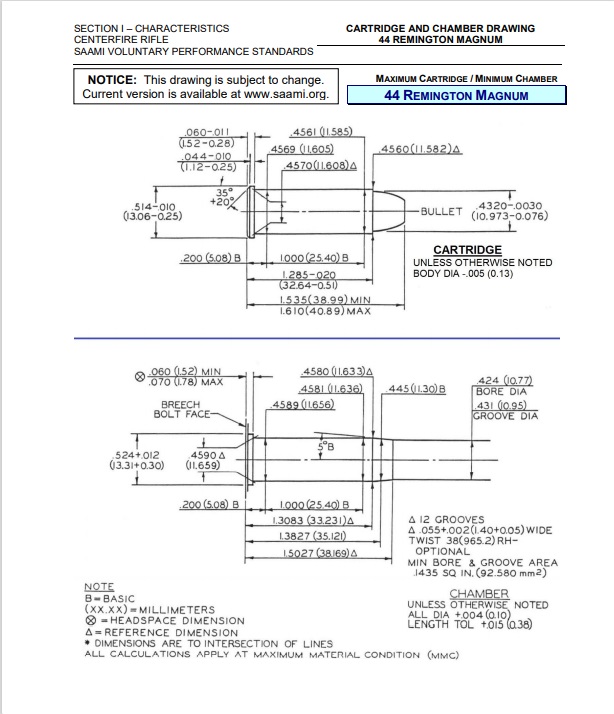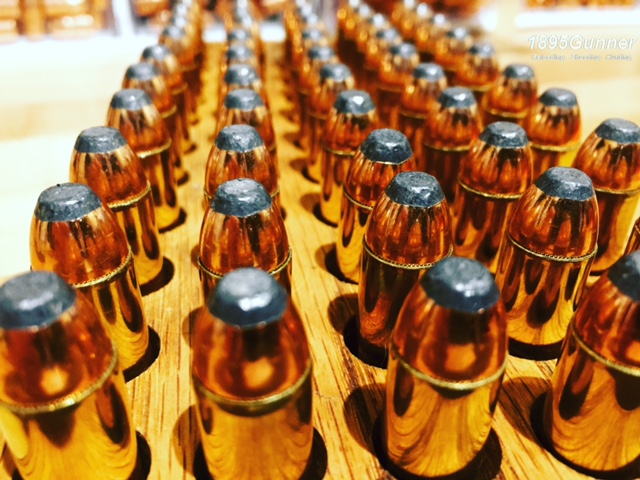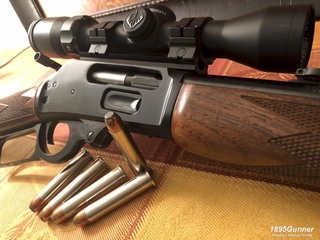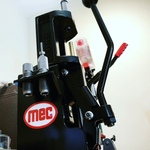 |
KNOWLEDGE CENTER1 8 9 5 G U N N E R.C O M
|
 |
KNOWLEDGE CENTER1 8 9 5 G U N N E R.C O M
|
Home > Knowledge Center > 44 Magnum44 MagnumHistoryIn 1956, Remington and Smith & Wesson released the .44 Remington Magnum cartridge as a chambering for the new Smith & Wesson model 29 revolver. Sturm Ruger also announced a new revolver for this cartridge, having somehow apparently gained access to either cartridges or spent cases during its development.Initially factory loads for the .44 Remington Magnum propelled a 240 grain .430” bullet at around 1,450fps. During product testing, Elmer Keith described the model 29 as being pleasant to shoot but many hunters found that its recoil stung the hands, so much so that the .44 Remington Magnum was not immediately popular, even after loads were reduced to 1,350fps. Then in 1971, Hollywood brought the .44 Remington Magnum to the big screen via the movie Dirty Harry, starring Clint Eastwood. Following this, the .44 Magnum became so well known that even non-gun owners learned that the .44 magnum was at that time the most powerful handgun in the world. As time passed, the .44 Magnum became available in a variety of pistols and rifles while being supported by a wide selection of factory ammunition. This incredibly successful cartridge has been used to hunt pretty much every game animal on earth. It is no longer the most powerful handgun cartridge in the world, knocked off its pedestal by such cartridges as the .454 Casull, the .460 Ruger, the .475 Linebaugh and the .500 S&W.
PerformanceAs a hunting cartridge the .44 Magnum produces varied results depending on whether it is fired in a rifle or pistol It may perhaps help the reader further to relate the fact that a .444 or .45-70 Marlin rifle loaded above 2,100 fps, is capable of rendering internal wounds up to three times larger than a .44 Magnum handgun loaded to 1,250 fps. This is not exactly comparing apples with apples yet the point remains that there is simply no substitute for raw power.Hunting rifles for the .44 Magnum come in a variety of flavors. The lever action rifles are certainly very stylish, handy and effective for hunting at very close ranges (including shooting over dogs). But some measure of objectivity does need to be applied. In dense and dark bush such as that found in New Zealand, open sighted rifles can be very difficult to use beyond 25 yards, especially at dusk and or with aging eyes. Those few precious seconds trying to draw a bead can lead to lost opportunities. Further issues can occur when shooting across open country, such as occurs if we break out of the bush and onto river flats. A 125 yard shot seems like an easy accomplishment in theory. But if our heart rate is high, the small light weight rifles can be difficult to settle. As for accuracy, the lever action .44’s can be somewhat problematic. Loaded to full speeds the .44 generates a good measure of harmonic force. Along with this, the lever action rifle forends cannot generally be free floated, the net result being potentially poor accuracy. In some instances the very act of disassembly, applying grease to weather proof the rifle followed by reassembly is enough to upset the apple cart. That said, it is imperative that gun owners perform such maintenance. Single shot rifles have also become popular in recent years including the Rossi Pomba (Wizard) and Bergara CVA. As with lever actions, the forends of these rifles cannot be floated. But unlike the levers there is no tube magazine interference to contend with. Further to this, the hinged block which mates to the barrel is generally so solid as to act as a dampening force, enough to overcome the harmonic forces of the .44. The twist rate of the Rossi is 1:30 while the Bergara has a 1:20 twist. Both rifles can be coaxed to produce reasonable and sometimes outstanding accuracy.
Factory ammunitionBefore we begin, readers are advised to take note that most published factory load data for the .44 Magnum is derived from 4” test barrels. Those using longer 6 to 7” barreled handguns should add an additional 150 fps to approximate average velocities. Those using carbine rifles (16” or longer) should add an additional 400 fps to the 4” barrel data. More information on this subject can be found via the excellent website Ballistics by the inch.Remington, the original creator of the .44 Magnum currently produce four loadings for use in both handguns and rifles. Remington list the 180 grain UMC jacketed soft point at a rated velocity of 1,610 fps from a 4” barrel (above 2,100 fps in 20” barreled rifles). Gone is the Remington UMC 180 grain semi jacketed hollow point. Although designed primarily for self-defense against humans, both loads are (or were) adequate for hunting game weighing around 44 to 132 lb. Both bullets are capable of exiting light bodied game with cross body shots. Remington produce two 240 grain loadings under their High Terminal Performance (HTP) banner, a semi jacketed hollow point and a deeper penetrating jacketed soft point. Muzzle velocities are 1,180 fps from 4” barreled handguns and around 1,600 fps in carbines. From a handgun these velocities are too low to expect high wound trauma. Using either load, the handgun hunter should expect clean but delayed kills. From rifle barrels these loads are not fast enough to produce hydrostatic shock, but do produce wide and fast bleeding wounds at close ranges (inside 50 yards). Of the two loads, the hollow point produces broader wounding. The soft point should only be used where deep penetration is of the utmost importance. Winchester produces five loads for the .44 Magnum. The first is the 210 grain Silvertip hollow point which achieves around 1,250 fps in handguns and around 1,650 fps in rifles. Unlike the aluminum tipped rifle bullets of old, the word Silvertip merely alludes to the anti-corrosive Nickel plating on the handgun projectile. The bullet is otherwise almost identical to a Hornady XTP in its basic design. The Silvertip load is designed for self-defense but is actually ideal for hunting lighter weight deer species at close ranges. The Silvertip does shed some weight at carbine rifle velocities, but not in any detrimental way. Penetration is limited more by the overall form of the expanded bullet than bullet weight loss. On the other hand it is this change in form which makes the Silvertip so effective on lighter medium game. Hunters should not overlook this bullet. The 240 grain Winchester Super X hollow soft point has for many years been the standard load used by pig hunters when shooting over dogs. This load is rated at 1,180 fps but shows excellent results in carbines, boasting velocities of up to and over 1,750 fps. The Super X features a semi jacket with a good deal of exposed lead to promote rapid expansion, being similar to Remington’s 240 grain loading. The 240 grain HP is too slow moving (even at carbine rifle velocities) to produce much in the way of nervous trauma, but it does generate broad internal wounding at impact velocities above 1,400 fps. At lower speeds and in the absence of any major hydraulic forces, the HP is reliant on mechanical wounding but manages to do so via its wide frontal area. The Super X is a very basic conventional bullet design yet like the Remington load, it performs very well. Winchester also produce a very basic 240 grain Super X jacketed soft point load which produces similar velocities to its hollow point counterpart. This is a slow to expand, deep penetrating bullet design. Even at rifle speeds, the JSP will retain most of its weight when used at close ranges. Although very basic in design, the old Super X JSP can be used on relatively large animals, handling heavily shielded mature wild boar without issues. The 240 grain Dual Bond is one of Winchesters more recent designs. Muzzle velocity is rated at 1,300 fps for handguns, producing an average of around 1,800 fps in carbine rifles The final load from Winchester is the 250 grain Platinum load rated at 1,250 fps, producing around 1,650 fps in carbine rifles. This projectile has the same nickel plating as the 210 grain Silvertip and is also designed to produce extremely rapid expansion. The Platinum bullet expands to around .75” which is about normal for .44 caliber hollow point ammunition Federal currently produce ten loads for the .44 Magnum, enough to confuse and frustrate the most patient of customers. Federals Powershok budget loads feature a 180 grain jacketed hollow point at a true 1,650 fps in pistols and over 2,100 fps in rifles, along with a 240 grain jacketed hollow point at 1,350 fps for pistols and around 1,750 fps in rifles. Federal’s premium loads include the 225 grain Barnes XPB at 1,280 fps and 1,650 fps respectively, the 240 grain Fusion at 1,300 and 1,800 fps, the 270 grain Hammer Down for rifles at 1,700 fps, the 280 grain Swift at 1,170 and 1,550 fps, and finally the 300 grain Cast Core large game hunting bullet loaded to 1,160 fps and 1,550 fps respectively from a carbine rifle. Hornady list five loads for the .44 Magnum. Unfortunately, the 180 grain XTP is no longer among these loads. Current loads include the 200 grain XTP at 1,500 fps (7.5” test barrel) and 1,900 fps in carbine rifles, the new 200 grain MonoFlex, the 225grain FTX producing 1,400 fps and 1,800 fps respectively, the 240 grain XTP at 1,350 fps and 1,700 fps, and finally the heavy 300 grain XTP at 1,150 fps and around 1,400 fps in carbine rifles.
Hand loadingTwo of the very best powders for reloading the .44 Magnum include Winchester 296 and Hodgdon H110, which if I am not mistaken, have for some years been the same powder. From a 7.5” hunting revolver barrel typical working velocities for the .44 Magnum include 1,900 fps with the 180 grain XTP, 1,750 fps with 200 grain bullets, 1,600 fps with 225 grain bullets, 1,500 fps with 240 grain bullets, 1,400 fps with 265-270 grain bullets and up to 1,300 fps using 280 to 300 grain bullets.From a 16 to 20” barreled carbine top velocities include 2,300 fps with 180 grain bullets, 2,100 fps with 200 grain bullets, 1,900 fps with 225 grain bullets, 1,800 fps with 240 grain bullets, 1,600 fps with 265-270 grain bullets, 1,500 fps with the 280 grain Swift and 1,400 fps with heavy 300 grain loads.
Final thoughtsThe .44 Magnum is a potent cartridge and a great deal of fun to shoot. The carbines make for useful farm tools and compact hunting rifles while handguns are guaranteed to put an ear to ear grin on any shooters face. But like all cartridges, the .44 Magnum has its strengths and limitations. This cartridge is best utilized for woods hunting, regardless of the many long shots that have been taken with it. Having said this, in order to obtain optimum results I advise all .44 shooters to work toward optimum accuracy and to study trajectories out to and beyond 100 yards. Like any tool, the more you get to know the .44, the better it can be put to use.
 |
| |
|
|
 |
 |
 |
 |
 |